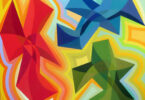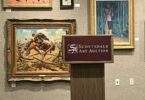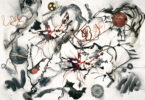Two particularly intriguing exhibitions at the New York Center for Photographic Art remind us of how great an art form photography can be. Black and White 2014 calls to mind Ted Grant’s statement that “When you photograph people in color, you photograph their clothes. But when you photograph people in black and white, you photograph their personalities!”
Portraits 2014 runs the full gamut from black and white, to color, to combinations of both, and immortalizes subjects ranging from aged war veterans to noble wilderness lions… and just about everything in between.
Let’s start with Colton Clifford’s Grand Prize entry for “Girl at Bedside.” The subject engages the viewer with a melancholy stare, eerily backlit by sunlight filtered through faded curtains. She’s serenely sitting on the bed, hands neatly resting on her lap but it’s her expression that’s a challenge. She’s as ambiguous as the Mona Lisa. Is the sun setting over a moment long passed or rising with muted joy on a day that’s been a long time coming? There’s no ambiguity with Robert Moran’s “Daughter of a Slave-Timbuktu.” A study in four shades of grey, the subject’s deep black pupils burn in stark, diametric opposite to the whites of her eyes. Her fierce expression doesn’t permit the viewer the comfort of staying in middle ground…you’re either with her or against her.
Lisa Powers “Woman in Red, Portrait of Karen Green” presents a gorgeous muted palette of saturated reds, creamy whites and pale greens, blending and washing together as if from a real water color. The face is lit starkly from one side, a sharp edge splitting the profile in half. It’s a painterly rendering expressed in broad colors and shapes.
My eyes play tricks on me when I look at Natalia Toskina “In Motion”. It continues the retro theme, this time with layered reflections and muted colors. The figures bounce back and forth between strata of highlights and shadows, the bride behind the window eclipsed by the shadow of the figure looming outside. Her concerned expression blurs the narrative of what would normally be a happy occasion. There are winners and losers here although it’s not clear who.
Bob Demchuk’s “Billy the Inventor” stares back at us through a lens of it’s own. The subject is literally looking through a magnifier. His thoughtful gaze seems like he’s looking through the page examining the viewer even as we stare back at him. His skin, textured and lined with age frames a face that’s still alert and curious. Go ahead, take your time and take a good look at me. I’ll be doing the same at you.
Where “Billy the Inventor” was a tongue in cheek metaphor for a subject’s relationship to the viewer, Cheryl Elich-Krumpelt’s “Artpoetography the Takeover” has the gory, over saturated tones of a horror movie poster. The figure is screened behind shattered glass, eyes open and blank, almost bloodshot. Lips apart in an airless gasp. There’s a suggestion of a tie around the subject’s neck but the longer you look at it, the more it looks like a noose.
Phillippe Halsman was a Magnum photographer famous for celebrity portraits. In his heyday he was noteworthy for a particularly kinetic photo of Salvador Dali that consisted of cats, water and assorted furniture liberally being tossed across the frame. His “jump” series was particularly disarming as he managed to get dozens of the rich and famous, (Marilyn Monroe, Richard Nixon, the king and queen of England to name a few) to jump while being photographed and be frozen in midair. I suppose the theory was it’s hard to put on airs when you’re, well, in mid air. Sam Smith’s entry is titled “Phillippe Halsman” but it’s not clear, at least to me what the association is. Two figures in profile with the face of the rear figure partially eclipsed by a pure black silhouette. The implied suggestion is that it’s almost a shadow of the rear figure captured onto photo paper.
If in some alternate universe, Botticelli lived in some random American suburb rather than the Italian Renaissance, his painting of the Birth of Venus might have looked like Zorica Purlija’s “YMI Bedroom”. The similarities are there, from the innocent tilt of the head right down to the full lips and incandescent eyes. If you need a nautical reference just substitute the surf and shell with her modest bikini top. Instead of a blue sky, the glow in the dark stars applied to the walls of her room stand in for the firmament. The expressions on both, wistful sadness.
I’ve lived in New York for most of my life but there are sections of the outer boroughs that still seem as remote to me as parts of Africa. Elisabeth Stiglic “Alan” looks like it was shot in the far outreaches of Brooklyn or Queens. The low, squat row of houses frame in a desolate street and empty sky. For an urban environmental portrait, the complete absence of other people is subtly unsettling. The figure’s green t-shirt reflects the color of the trees; he’s evolved to become a creature of this environment. I wonder how many orbits of that block he’s made growing up there?
I find myself reflexively holding my breath every time I look at Dianne Yudelson “Under the Surface 11”. The female figure, immersed in water gives no hint of distress even as bubbles serenely stream to the surface. Whatever the emotional statement, the rippled blue water and visual distortions applied by being submerged makes it a visual pun, a true watercolor.
In the black and white category, Anita Schiedeck “Beine” captured the grand prize. Apparently, beine is German for leg and as you may have guessed, the photo is a slightly enigmatic rendering of a pair of legs emerging from a shroud. The lace on the hem of the dress suggests Marlene Dietrich or some other femme fatale. It’s a challenge to reconstruct the rest of the person based on a part. Perhaps that’s the point.
Terri Gold’s “Surma Family in the Omo Valley” could have been a page ripped from an issue National Geographic. The native figures look impossibly elongated and lean, every inch of the men’s bodies garishly decorated with swirls and lines and exotic body paint. To the left, a woman nurses an infant looking forlorn and just a bit impatient at the display.
A lone figure with an umbrella is silhouetted against a snowy landscape. In Linda Sandow “So Many Journeys #4” the curved sweep of the foreground hems in his walk and defines his path. It’s a single orbit. One cycle.
Len Speier “VW Bug, New York City” is a charming reduction of shapes and colors. The VW bug has long since attained icon status. Here, clever placement juxtaposes its curves in graphic contrast to a rectangular bank of white framed windows. There are barely three shades of gray in the entire image. The sheer minimalism makes this play out like a page from a children’s book.
“#3 Time and Time Again” is a diptych by Henriette Mordrup. A airplane lies tilted unnaturally onto it’s nose framed in by rows of onlookers. In the other a figure lies prone, his head dipped in manhole cover, one arm held high, mirroring the disposition of the plane.
A desolate, wintry landscape, bisected by a running stream, the trees in the background blurring and disappearing into the fog. David Morel’s “Fog and Ice” evokes your worst notions of midwinter blues.
More a death mask than a portrait, Antonella Renzi’s moody “Portrait #3” presents a solemn figure, eyes shut but with lids glowing luminously. The technology could be a pin camera or an old daguerreotype from the 1870s. That it’s contemporary is probably it’s biggest surprise, a modern subject rendered out of time.
“Bringing the Stone Tablets” evokes Moses descending from Mt. Sinai. Ralph Hassenpflug’s desolate, ambiguous figure girdled with a wind blown shroud seems to pay homage to that.
Francine Meckler “Mongolia Highway” looks about what you’d expect a highway in Mongolia to look like. No pretensions here. The windscreen of the car frames in a herd of sheep, the road blocked and flowing off into endless steppes. In a world where some indefinable percentage of humanity is permanently stuck in bumper-to-bumper traffic, it’s a delightful escape to be reminded of places where the sidewalk ends.
Finally, Anita Schiedeck “Tuba” presents a small world reflected within it’s brass horn. Positioned and lit as it is, it almost looks like a rip in space, swallowing up the trees and houses as they spiral down and disappear.




